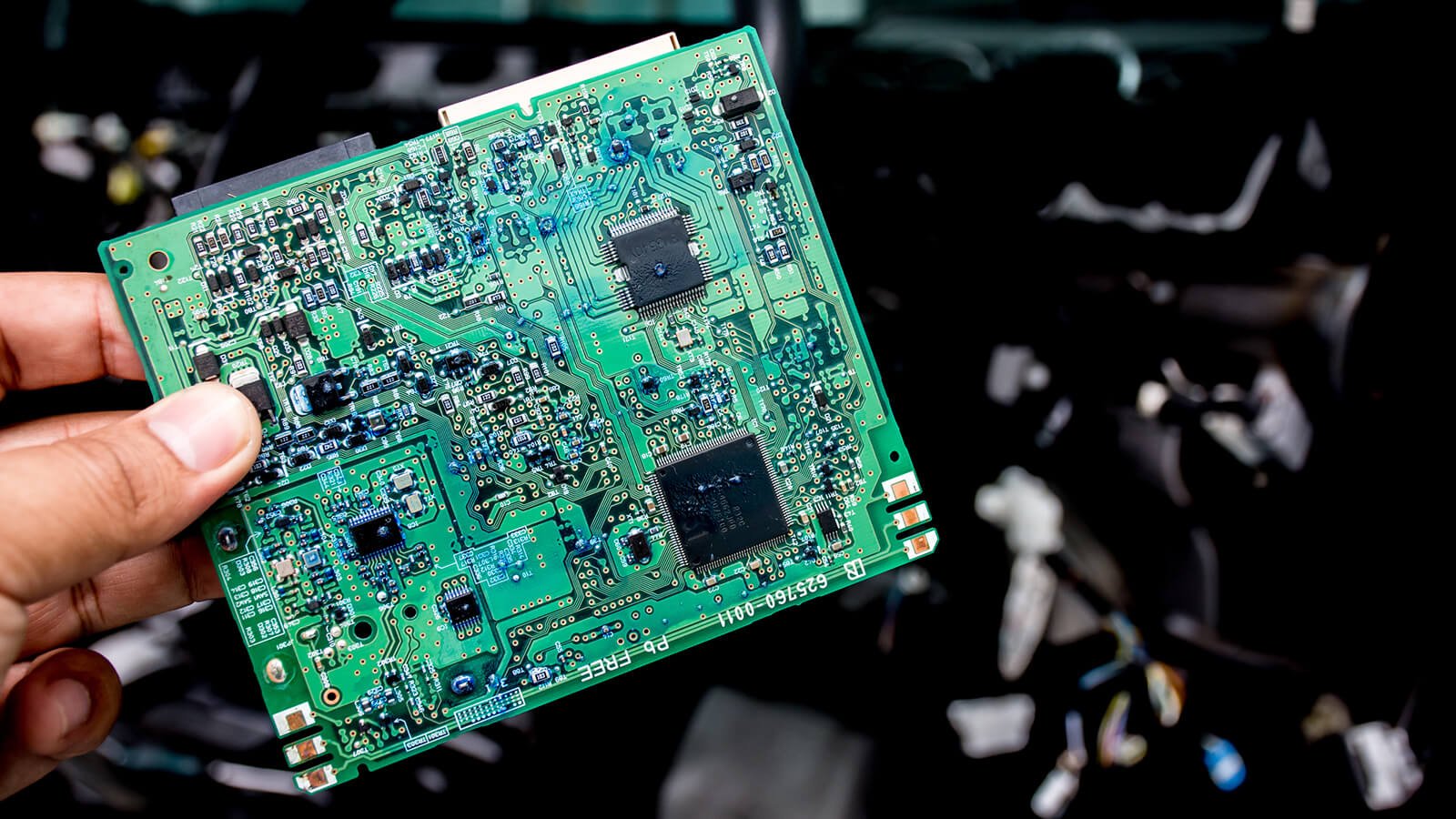Quite possibly the most critical systems in modern-day vehicles, electronic control units (ECUs), are responsible for overseeing, regulating, and altering the operation of a car’s electronic system. ECUs control many aspects of the vehicle, including power steering, anti-lock braking, fuel injection, and interior cabin comfort through air conditioning or music from a favorite radio station. Most modern cars contain up to 80 ECUs, and these systems will continue to multiply with technological improvement and the introduction of new features. Each of these ECUs must integrate into the vehicle infrastructure.
Since ECUs facilitate features directly impacting vehicle operation and overall user safety, reliable operation is crucial to maintaining peak performance standards. One example is the engine control module (ECM), which regulates a series of actuators in a vehicle’s engine to ensure optimal performance. These units can control engine operation and management variables, including air-fuel ratio, idle speed, and ignition timing. If an ECM fails, the vehicle typically will not start. Consequently, these units are expected to perform for the vehicle’s lifetime – the EPA mandates that vehicle manufacturers warrant engine control modules for eight years / 80,000 miles.
Replacing these units is costly and can exceed over $1,500 in parts alone. Often, ECUs are placed throughout the vehicle and can be exposed to various stringent operating conditions, including environments with corrosion, moisture, vibration, and heat. The engine control module is located in the vehicle engine bay and is exposed to these harsh environmental conditions. Regardless of the type, protection of ECUs is imperative to ensure that these devices can reliably perform throughout the vehicle lifecycle despite regular exposure to undesirable settings. The most common threat to ECU reliability is highly corrosive environments produced by exposure to humidity or moisture.
Regardless of the type, protection of ECUs is imperative to ensure that these devices can reliably perform throughout the vehicle lifecycle, despite regular exposure to undesirable settings.
Seals or enclosures, typical protection methods for electrical control units, are designed to prevent moisture ingress but cannot provide further protection once moisture penetrates. Unfortunately, they become worn throughout operation due to stresses endured from heat, vibration, and general use, creating voids for moisture and humidity access that can lead to ECU damage and inoperability. In addition, these protection methodologies can create complexities and design limitations as ECU form factors continue to be optimized for vehicle size and fit.
| Protection Characteristics | Unprotected PCB | Mechanical Seal | Silicone/Acrylic Coatings | Parylene Coating |
|---|---|---|---|---|
| Protection Barrier | None | Good, but can be compromised with drops & temperature. | Good, but can be thick & porous depending on the application. | Excellent. Can peel if not properly applied. |
| Hydrophobic | No | No | Yes | Partial |
| Thickness | N.A. | Millimeters | μm – Millimeters | 2μm – 50μm |
| Protection Against Water | Poor | Good – Ingress Poor – Penetration | Good | Excellent |
| Salt/Chemical Protection | Poor | Poor | Varies | Excellent |
| Durability | Low | Varies | Varies | High |
| Submersion Test Time to Failure | Seconds (IP Rating N.A.) | Varies | Varies | Days to Weeks (IPX7 – IPX8) |
Parylene Performance Characteristics Versus Competitor Solutions
On the other hand, conformal coatings (thin polymeric films applied directly to substrates and components) can be customized to the application environment, provide robust protection, and allow for lighter and smaller ECU assemblies. They may reduce the need for traditional seals or enclosures altogether. However, choosing a suitable conformal coating material is imperative because selected chemistries can directly impact ECU functionality and reliability. Traditionally, acrylics, epoxies, and silicones have protected printed circuit board assemblies (PCBAs) in ECUs from environmental contamination. Still, these materials require substantial layering and thickness to demonstrate protection benefits. And as electronics continue to miniaturize and increase in overall complexity, conformal coating weight and application footprint are essential variables to consider when evaluating protection alternatives to minimize bulk.

HZO’s Parylene coatings are a natural fit for ECU applications due to their demonstrated performance across various test parameters and application environments. Considered the gold standard, Parylene conformal coatings come in various types and have nearly 50 years of reliable, durable, and long-lasting performance across industries. The coating is superior in uniform coverage, barrier properties, and performance at comparably thinner films, with less stress on mechanical structures and virtually no added weight.
| Class | Type | Specimen – Average Coating Thickness [μm] | |||
|---|---|---|---|---|---|
| 1 | 2 | 3 | 4 | ||
| XY | Parylene N | 25 | 25 | 23 | 23 |
| XY | Parylene C | 31 | 30 | 30 | 32 |
| XY | Parylene F | 46 | 36 | 43 | 29 |
| AR/UR | Acrylic | 73 | 73 | 69 | 72 |
| SR | Silicone | 102 | 99 | 114 | 154 |
| AR/UR | Acrylated Polyurethane | 91 | 91 | 107 | 107 |
HZO’s Parylene passed all IPC CC-830C at 50% of the Film Thickness of the Traditional Conformal Coatings
Unlike liquid conformal coating methods that may lead to coating defects, Parylene coatings are unique in their ability to be polymerized and deposited by vapor deposition onto substrates maintained at room temperature. The result is extremely thin, pinhole-free, high-purity coatings that fulfill the reliability requirements of automotive design. Parylene is highly conformal, offering the best protection also on corners & edges of components, creating a thin 3D-type film across the PCBA. The highly conformal and microns thin coating offers design flexibility & results in extremely low contact / interfacial resistance. These properties are due to the chemical vapor deposition (CVD) process specific to Parylene. Parylene is also unique due to its ability to be deposited in several chemical variants, demonstrating unique film performance characteristics.
Each Parylene composition offers exceptional salt, mist, moisture, dust, and environmental protection. However, some Parylene types exhibit performance qualities that excel in specific circumstances or application environments. Examples of these variants include Parylene C, which is the most effective conformal coating available for corrosion protection at its thickness. Parylene F exhibits superior thermal resistance and is ideal for maintaining protective performance while exposed to high heat.
Watch our webinar on proven methods of corrosion resistance
| Polymer | Gas Permeability at 25 °C, (cc·mm)/(m2·day·atm) | WVTR,(g·mm)/(m2·day) | ||||||
|---|---|---|---|---|---|---|---|---|
|
N2 |
O2 |
CO2 |
H2 |
H2S |
SO2 |
Cl2 |
||
| Parylene C | 0.4 | 2.8 | 3.0 | 43.3 | 5.1 | 4.3 | 0.1 | 0.08 |
| Parylene N | 3.0 | 15.4 | 84.3 | 212.6 | 313 | 745 | 29.2 | 0.59 |
| Parylene D | 1.8 | 12.6 | 5.1 | – | 0.6 | 1.9 | 0.2 | 0.09 |
| Parylene F (VT-4) | – | 16.7 | – | – | – | – | – | 0.28 |
| Epoxy (ER) | 1.6 | 4 | 3.1 | 43.3 | – | – | – | 0.94 |
| Polyurethane (UR) | 31.5 | 78.7 | 1,81 | – | – | – | – | 0.93 |
| Silicone (SR) | – | 19,685 | 118,110 | 17,717 | – | – | – | – |
Water vapor transmission rate and gas permeability indicate barrier effectiveness for corrosion resistance. The chart illustrates that Parylene C’s WTVR and permeability properties are exceptionally low. HZO-coated automotive assemblies were exposed to HAST (Highly Accelerated Temperature and Humidity Stress Test) at 130 °C and 90% RH for 48 hours while powered at 14 V and a sampling rate of 0.5 Hz. HZO coatings pass by, preventing any current spikes over 0.5 Amps.

Parylene F is best suited for operating temperatures in the -55 °C to 200 °C range, while Parylene C can be utilized from -55 °C to 85°C. Exposed to the HAST conditions described above, Parylene F films would best serve applications like ECMs found in the engine compartment and exposed to high-temperature environments. Parylene C is a better alternative for corrosion protection for ECUs in areas of the vehicle that do not have high-temperature considerations but need resistance to moisture, humidity, salt, or other chemical exposure.
HZO’s Parylene coatings can offer superior protection for automotive applications like ECUs and have demonstrated aptitude through various testing methodologies to meet necessary performance requirements and specifications. In addition, we have experience with the PPAP process to assure that production parts will be executed in a highly repeatable and quality-focused manufacturing environment. Our unique ability to handle large and complex parts due to proprietary coating and automation equipment with exceptionally high yield rates makes us well-suited to the automotive industry.
Meanwhile, HZO’s customer-focused solutions can be delivered with highly customizable end-to-end business models as our dedicated engineers and SMEs work with clients through every step of the coating process. If you have any questions about our automotive conformal coating services, contact us, or if you think we might be appropriate for your next project, request a quote today.

